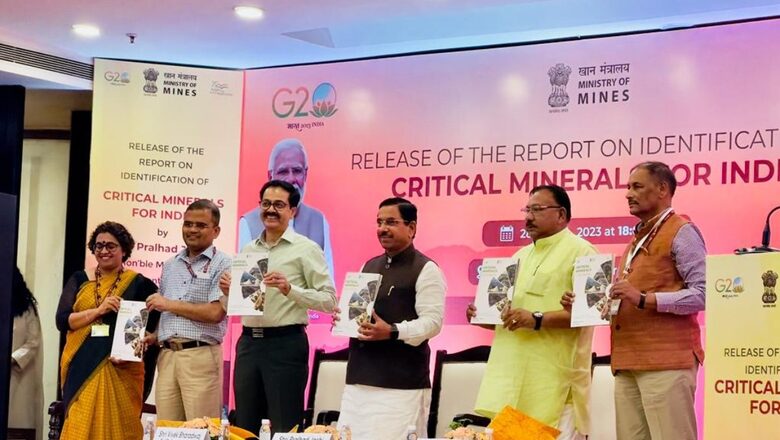
views
This week has brought a new wave of focus on critical minerals in India. First, India got invited to join the US-led ‘Mineral Security Partnership’ (MSP), and second, it introduced a list of 30 critical minerals in order to guarantee “self-reliance” and address “vulnerability” in its supply chain.
The supply chain crisis, combined with the rising importance of critical minerals for renewable energy and high-tech industries, enhanced their global importance. This has led all major powers to introduce their own focused lists of these minerals along with developing strategic partnerships, most particularly with China, the US, Australia, the European Union (EU), Japan, Canada, and now India (see Table 1). This article intends to analyse the potential and significance of India in the global critical mineral club by understanding its declared list, its partnership with major powers, and its strength in becoming a part of MSP.
Table 1- Countries with Critical Minerals List
Antimony
Beryllium
Cobalt
Gallium
Germanium
Graphite
Indium
Lithium
Manganese
Rare Earth Elements
Tantalum
Titanium
Uranium
Vanadium
Zinc
Zirconium
(Table Source: Compiled by the Author)
How Critical Minerals became a focus in India
It should be noted that India is a reservoir of 49 main critical and non-fuel minerals as reported by the Council on Energy, Environment, and Water (CEEW) and the Ministry of Science & Technology. In comparison to resource-rich regions like Australia and Africa, whose mining sector contributes 7-7.5 percent to the GDP, it is only 1.75 percent in India despite having over 95 types of minerals. It is an observation, by the Ministry of Mines, that only 10 percent of India’s geological potential has been explored. In 2021, India began to prioritise critical minerals as part of its National Mines and Minerals Development and Regulation (MMDR) bill, with an aim to reform the production capacity of India. The objectives of MMDR are to ensure transparency in the auction process of mines and to enhance domestic and foreign investment in the mining sector, which will certainly increase their contribution to the GDP and secure the supply of resources at the domestic level.
India’s Critical Mineral List
On Wednesday, India released its first complete list of critical minerals to meet the requirements of its key focused industries ranging from defence and agriculture to energy and pharmaceutical to telecommunications. Pralhad Joshi, Union Minister of Coal, Mines, and Parliamentary Affairs, released the first-ever study on Critical Minerals for India, which was compiled by an expert panel convened by the Ministry of Mines. For the first time, India has compiled a complete list of important minerals that meet the needs of industries ranging from defence and agriculture to energy and pharmaceuticals to telecommunications. The minister went on to say that this initiative is India’s road map to Aatmanirbhar Bharat.
The decision to arrive at 31 critical minerals was a three stage-assessment:
Stage I – Assessed critical minerals policies of various countries to estimate criticality parameters and identify critical minerals, and select 69 key elements/minerals for investigation.
Stage II – Based on inter-ministerial consultation, a list of critical minerals for different sectors or industries was identified.
Stage III – Ministry of Mines deliberated with IEA and CSEP to calculate the criticality index, and used the EU methodology that weighs economic importance and supply risk. Factors like substitutability, minerals cross-cutting, and import reliance were also considered.
The decided critical mineral list includes: Antimony, Beryllium, Bismuth, Cobalt, Copper, Gallium, Germanium, Graphite, Hafnium, Indium, Lithium, Molybdenum, Niobium, Nickel, PGE, Phosphorous, Potash, REE, Rhenium, Silicon, Strontium, Tantalum, Tellurium, Tin, Titanium, Tungsten, Vanadium, Zirconium, Selenium and Cadmium.
India’s Critical Minerals Partnerships
With 100 percent import dependence for about ten critical minerals, India has high import trading relations with some major powers (see Table 2), out of which China is the major source.
Table 2 – Critical Minerals with 100 Percent High Import Dependence
(Source:https://mines.gov.in/admin/storage/app/uploads/649d4212cceb01688027666.pdf)
In terms of the partnership, India has entered into some significant agreements as follows:
With Australia
India recently announced a joint grant to research new critical minerals exploration technology and, fund rare earth processing facilities in Kalgoorlie, Western Australia. Collaborations, such as the Supply Chain Resilience Initiative (SCRI) and the Quad, have taken shape at all bilateral, trilateral, and multilateral levels. The recent bilateral announcement to undertake a partnership on five target critical mineral projects (three cobalt and two lithium) also represents their strengthening supply chain collaboration. In 2022, Australia updated its India Economic Plan (IES) to 2035, to give priority status to the Mining Equipment, Technologies and Services (METS) sector in India. Since then, one of the five priorities of the Australia-India Business Exchange (AIBX) has been mining and resources, and about 40 Australian companies are reported to be involved in the Indian mining industry by 2022.
With the US
India has critical energy and green economy partnerships being shaped under agreements like the Partnership to Clean Energy Research (PACE) 2009, Strategic Energy Partnership (SEP) 2018, Partnership for a Green Future 2018, US-India Climate and Clean Energy Agenda 2030 Partnership 2021, and so on. In addition, India recently joined the US-led 11 members “Minerals Security Partnership” (MSP).
With Japan
India has six projects as part of the “Programme for the Supply Chain Resilience in the Indo-Pacific Region”, launched by the Japanese government in April 2022, with funding of US $8.6 million. In addition, India, Japan, and Australia formally unveiled the Supply Chain Resilience Initiative (SCRI) as an effort to lessen the Indo-Pacific region’s reliance on China.
Way Ahead
The key to India achieving all of its geo-economic goals, energy and renewable goals, mineral security, and commitment to electric vehicles by 2030, is the expansion of critical mineral exploration. Nevertheless, it is worth noticing that out of the 31 minerals listed, India is the least import-dependent for Manganese (50 percent), Chromium (2.5 percent), and Silicon (<1 percent), which can prove to be its strength in partnering with other countries. Moreover, the recent initiatives of the EU, Canada, Korea, and others in terms of securing critical minerals supply carry opportunities for partnership for India as well, which the future will unfold.
The author is Associate Fellow, Centre for Air Power Studies. Views expressed are personal.




















Comments
0 comment